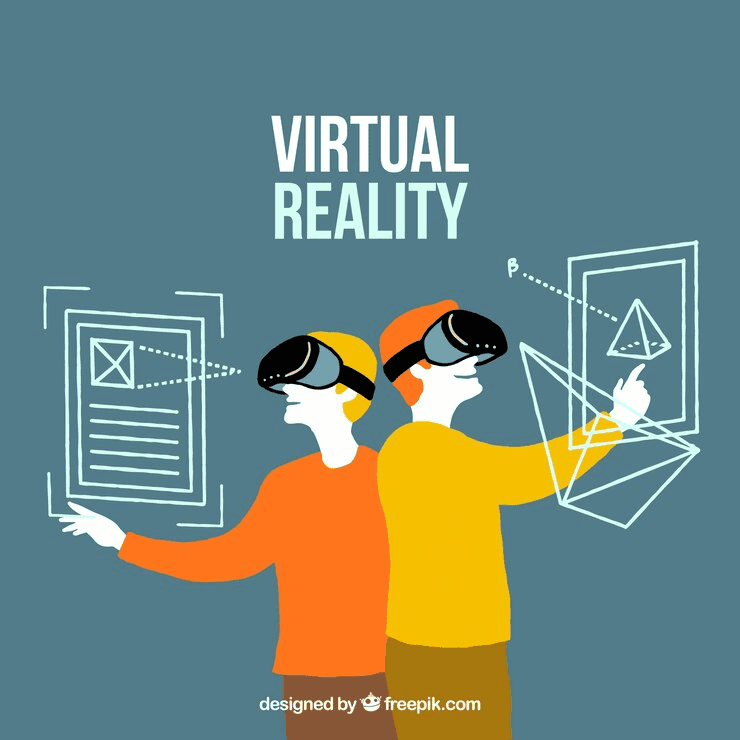Throughout the years, the social media marketing landscape has been undergoing an enormous transformation, particularly with the arrival of new and smart technologies, such as Virtual Reality (VR) and Augmented Reality (AR). These technologies, which at one time used to be paving the way for the future have now indeed been incorporated as very effective instruments essential for brands in their effort to interact with consumers in a highly immersive and interactive way. This article aims to uncover the most important role of VR and AR in social media marketing and the good and bad points that we have to face as well as the foresight of the future of these technologies.
Understanding VR and AR
It’s imperative to know what VR and AR are, along with their differences, before jumping into how these technologies are used in social media management software.
Virtual Reality (VR): The use of VR submerges users into a completely virtual environment. Through headsets that aid in the process, users are able to interact with and experience 3D-generated space and objects-an entirely digital world-whereas non-VR screens tend to isolate, establishing a lack of physical presence in their virtual worlds.
Augmented Reality (AR): AR reinforces the real world with virtual constructs. Instead of being transported into a completely virtual environment, augmented reality immerses the user in his immediate surroundings but throws some sort of 3D object, sound, or image on top of it. A blend of both the real and digital worlds is all that one gets. Moreover, when combined with augmented intelligence, AR can analyze user preferences in real time, offering even more personalized and adaptive experiences.
The Growing Popularity of VR and AR
VR and AR are more and more popular and the reasons can be the following:
Smartphone Advancements: State-of-the-art smartphones are now armed with strong processors, cameras and sensors, which can make them run AR applications. AR is now more reachable to the public by the fact that only a broad range of devices have the AR feature.
Consumer Engagement: The companies have come to the realization that the AR & VR can be a connector between traditional advertising and immersive and interactive live streaming experiences if they want to be in a position to compete. Because the individuals are always searching for more engaging and personalized experiences the companies realize that the AR & VR becomes the road to differentiate and to offer traditional advertising while having the potential to provide immersive and interactive experiences.
Affordable Technology: The prices of VR and AR gadgets have gone down to a great extent in the last years. This fact has made it possible for the enterprises of all sorts of activities to try these out in their marketing campaigns at a lower cost.
How VR and AR are Revolutionizing Social Media Marketing
VR and AR are the most benefited sectors of the social media platforms that utilize technology like VR and AR to the fullest and reshaping how users will interact with the brands and consume the content. As these technologies enhance user engagement, timing also plays a crucial role in maximizing reach. Knowing when to post on Instagram can significantly impact how audiences experience and interact with VR and AR-driven content. Here are some of the ways VR and AR are reshaping social media marketing:

Enhanced User Experiences through Immersive Content
Immersive content is the only way to bring consumers closer to a unique experience like never before that AR and VR technologies can present. These technologies enable brands to take their users into new worlds that are unavailable in reality. For example:
- Snapchat: The AR app remains the reigning concept for video chat in digital advertising. For instance, the company has brought several AR features like filters, lenses, and geofilters to its app. It is now possible for users to take branded lenses, which will superimpose fun filters on their faces or place virtual objects in their environment so they may interact with them. As for the business mentoring these lenses offer an exclusive opportunity to keep customers active and expose them to brand new products.
- Instagram: Instagram exposes the AR possibility in the story feature. You may be a makeup, clothes, or accessory model or the user to pretend to wear a virtual version of the product. Brands like Sephora and Gucci have developed these tools to provide a unique experience that both drives user engagement and conversions.
- Facebook: Facebook unveiled AR-enhanced ads where users can now see 3D items or products like furniture in their homes and interact with them. An ad that completely changed the way we advertise things and products ends up in their experience. Users can use this technology to check if some furniture fits in their homes or if a pair of shoes matches their style, before they buy the product.
Increased Brand Awareness
Using these technologies, it assists VR and AR to present brands in virtual reality and an augmented reality context while creating awareness and recognition beyond anything else that traditional media can provide, and brands have the opportunity to place themselves right at the centre of these stories.They are also able to connect emotional experiences to their products that customers would like to purchase.
For example, Instagram and Facebook AR ads are likely candidates for virality as a result of the dynamic content resonating with the content of users. And the brand customer may get such valuable services, thus leading to customer satisfaction, when people share their experiences with AR on their social channels, therefore, the brand is receiving lots of organic exposure and hence getting more visible to people.
In addition, VR offers a level of involvement that is capable of delivering a long-lasting impact. VR can be used by brands to present their products in ways that normal advertising channels cannot. As a case in point, a travel brand could make a virtual tour of a destination, giving potential customers a similar sense of the visit though they are miles away from the site.
Virtual Events and Product Launches
One way that VR and AR are affecting social media marketing considerably are the virtual events. VR platforms such as AltspaceVR and VRChat are a venue where firms can organize entirely virtual gatherings with the possibility of digital interactivity between users and the brand itself.
Moreover, such solutions provide an excellent solution for product launches as ICBC banks can set up 3D digital showrooms where users can play around with products, join live demonstrations, and also get in touch with company agents. It goes without saying that the outcome will be of a high standard characterized by a high level of user involvement.
Thus, brands have the possibility to create the extra excitement of delivering their products to the market.
Shoppable AR and VR Ads
Shoppable AR & VR commercials convert buyers’ interactions in new ways. Corporations that introduce AR & VR solutions enable their consumers to participate in the buying process by visualizing the products in their own surroundings or even trying them on without being there. Although the consumer experience is essential, the outcome is an increase in the conversion rate, too.
Moreover, IKEA is an example where AR is used. To have a view of what a particular piece of furniture would look like in their own house, the people are allowed to play furniture Houdini. By using the IKEA Home Assistant app, users can get to know directly a sofa, table, or any other light fixture that suits their living room.
Similarly, cosmetic brands like L’Oreal have created AR filters through which customers can view how they would look if they applied different shades of makeup. The convergence of VR and AR with social media platforms has made brands improve their sales volumes thus efficiently and enjoyably delivering shopping sales.
Personalization and Customization
Nowadays, personalized experiences represent a principal pillar of working technology, and virtual reality can be at the cutting edge of the identification of your personality. Using AR, users are capable of making changes on the spot to any of the products they are interested in, namely, the adjusting of the color of a car or the alteration of the design of a piece of clothes.
This functionality not only allows users to be more interested in the product selection but also facilitates them to make a purchase with more confidence. When combined with social media platforms, customized AR experiences encourage users to share their personally-created pieces of content with their social networks, hence furthering the rise of new traffic and engagement. HR automation also benefits from AI-driven personalization, enabling companies to create customized employee experiences, from onboarding to training, using AR-enhanced learning modules that adapt to individual needs.
Improved Customer Loyalty
AR and VR appear to be the cause of not only the naming of new inseparables but also the augmentation of the loyalty of those that already have it. Allowing brands to provide emotional relationships, they are either unique, fun and interactive online courses , with BBA and their consumers can help them develop a manual with these activities. Along with the emotional connections that branding experiences bring, come the loyal customers who are an essential part of the business which is a vital aspect for its long-term success.
Furthermore, VR and AR are designed to improve customer service through virtual customer support. For example, the user may enter the virtual environment and communicate with a representative in real time, receiving suggestions for product troubleshooting and/or making inquiries.
Challenges of Implementing VR and AR in Social Media Marketing
Virtual and augmented reality are the best solutions for many problems, require a lot of consideration from the side of the brand,
- High Initial costs: One thing that shows up among the constructing VR and AR content is the high start-up investment in technology, tools, and specialized skills.You also have the option to hire a software house, ensuring that professionals take care of your project with excellence. Most of the brands are not going to be able to undergo these high bills for the creation of immersive experiences.
- Accessibility issues: AR is a technology that is universally available through smartphones, unlike VR which requires the purchase of quality VR parts such as the Oculus Go. This results in the fact that originally such a campaign was intended only for a very small circle at the face of it. The target market reach will be quite limited
- Technical Issues: AR and VR displays are sometimes not working properly on different devices which can also lead to bad user experiences and brand perception issues.
- Content Creation Complexity: Brand marketing and the way AR and VR experiences are designed is a really difficult task as it asks for the right and most creative people to come up with new solutions. Advertisers should make sure they have the right employees as well as resources to come up with exciting and useful content that taps into the interests and desires of their audience.
- Privacy Concerns: AR and VR are such innovative developments to where user data such as the users’ position, facial recognition by the system, and habit patterns are usually gathered. Thus brands must be open up about the usage of this data and should have programs in place to adhere to the privacy regulations.
The Future of VR and AR in Social Media Marketing
Technology’s increasing influence over humanity directs one’s gaze to marvel at the imminence of AR and VR becoming a mainstay in the marketing of social media. Infrastructure improvements like 5G networks and AI and more powerful AR/VR devices will facilitate the further penetration and progress of the said technologies.
In the years to come, we could anticipate more frames that will serve as the magic key to data transmission between the real and virtual worlds. More brands will probably continue with virtual reality and augmented reality to them to create actual experiences and keep them committed with personalized interaction.
Thanks to the technologies’ potential to alter customer experience, stimulate sales, and promote brand recognition, VR and AR are anticipated to assume a more vital role in social media marketing.
Final Thoughts on VR and AR in Social Media Marketing
Virtual Reality (VR) and Augmented Reality (AR) are two game changers in the field of social media marketing. By providing experiential and interactive things, these technologies bring about a shift in the way companies bond with the people. The potential benefits range from improving the user engagement to increasing the sales.
Yet, brands should also recognize that the difficulties such as cost and availability may be encountered in the process of VR and AR. With the right approach, these technologies can make social media marketing a leap into a new stratosphere, thus bringing the marketing of the future even closer to the people than ever before, that can only be defined as interactive, immersive, and personalized.


